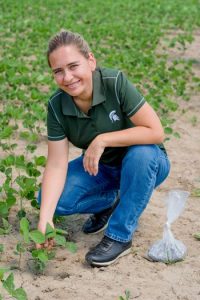Soybean Cyst Nematodes
By Dusty Sonnenberg, CCA, Ohio Field Leader, a project of the Ohio Soybean Council and soybean check-off.
“Soybean Cyst Nematode (SCN) is the most important nematode in soybeans because it causes the most damage. It is the number one yield robbing soybean pathogen in North America,” said Dr. Marisol Quintanilla, Michigan State University Extension Nematologist.

It is important for a farmer to know if they have SCN in their field, and at what level. “A key in SCN management is to try to avoid getting it in the field. The first step is to sample and determine if it is present or not. Collect soil samples and know your numbers,” said Quintanilla. “Some labs can also determine the type of SCN present.”
If SCN is not present, then the goal is to keep it out. “SCN cannot spread on its own,” said Quintanilla. “SCN needs to be spread by something that moves soil, (such as tillage or planting equipment).”
If SCN is present, a good practice is to rotate resistant varieties, and also rotate with non-host crops. “If you have SCN, the best advice is to grow a non-host, such as a grass crop like corn or wheat,” said Quintanilla. “Another very important practice is to rotate sources of resistance. Most SCN is not impacted by PI788. The Peking resistance may be a better option. There are nematode-protectant seed treatments available in the market, however they are not the best option as the effectiveness is less than crop and variety rotations.”
Soil type and characteristics can impact SCN levels. “Some soil qualities favor SCN. Soil that has as high soil pH and course textured soils like sands are more favorable to SCN,” said Quintanilla.
Composted manure trials conducted at Michigan State University in the greenhouse have shown the ability to lower SCN numbers. “It is dependent on the amount and type of manure,” said Quintanilla. “Layer Ash and Poultry Litter at high levels showed some level of effectiveness. Nematodes exposed to Layer Ash blended at a 5% rate experienced 0% survival. Nematodes treated with poultry manure experienced gradually decreasing survivorship until 50% where mean survivorship equaled 0%. Only at rates of 75% compost or higher, was nematode survivorship in Dairy manure treatments substantially lower than the control.”
The use of cover crops can also impact SCN. Michigan State University Extension (MSUE) ran a greenhouse evaluation of cover crops as a SCN trap crop for SCN management. The cover crop treatments included: red clover, cereal rye, oilseed radish, and mustard. The goal was to determine if there are some cover crop species that reduce SCN numbers in a soil, or if there are cover crop species that act as a trap crop.
SCN resistance is continuously being evaluated for resistance effectiveness. MSUE studied different rotations of SCN resistant varieties. These included: PI788, Peking, PI788+Ilevo, Peking+Ilevo, and a susceptible variety. “In 2017 all the varieties tested had a statistically similar yields and nematode numbers were similar in all the plots,” said Quintanilla. “By 2018 a statistically significant difference among the treatments began to emerge. The highest yield and lowest nematode numbers occurred when the resistant varieties were rotated with each other. The nematode numbers increased, and yields decreased when the same resistance variety was planted in successive years. The lowest yields and highest nematode numbers occurred when a susceptible variety was rotated with a resistant variety. The same occurred in 2019 and 2020. The results clearly showed that the best thing a farmer can do when a field is in continuous soybeans is rotate sources of SCN resistance. An even better option is to rotate to a non-host crop in alternate years, and also rotate resistance varieties in the soybean years. ”